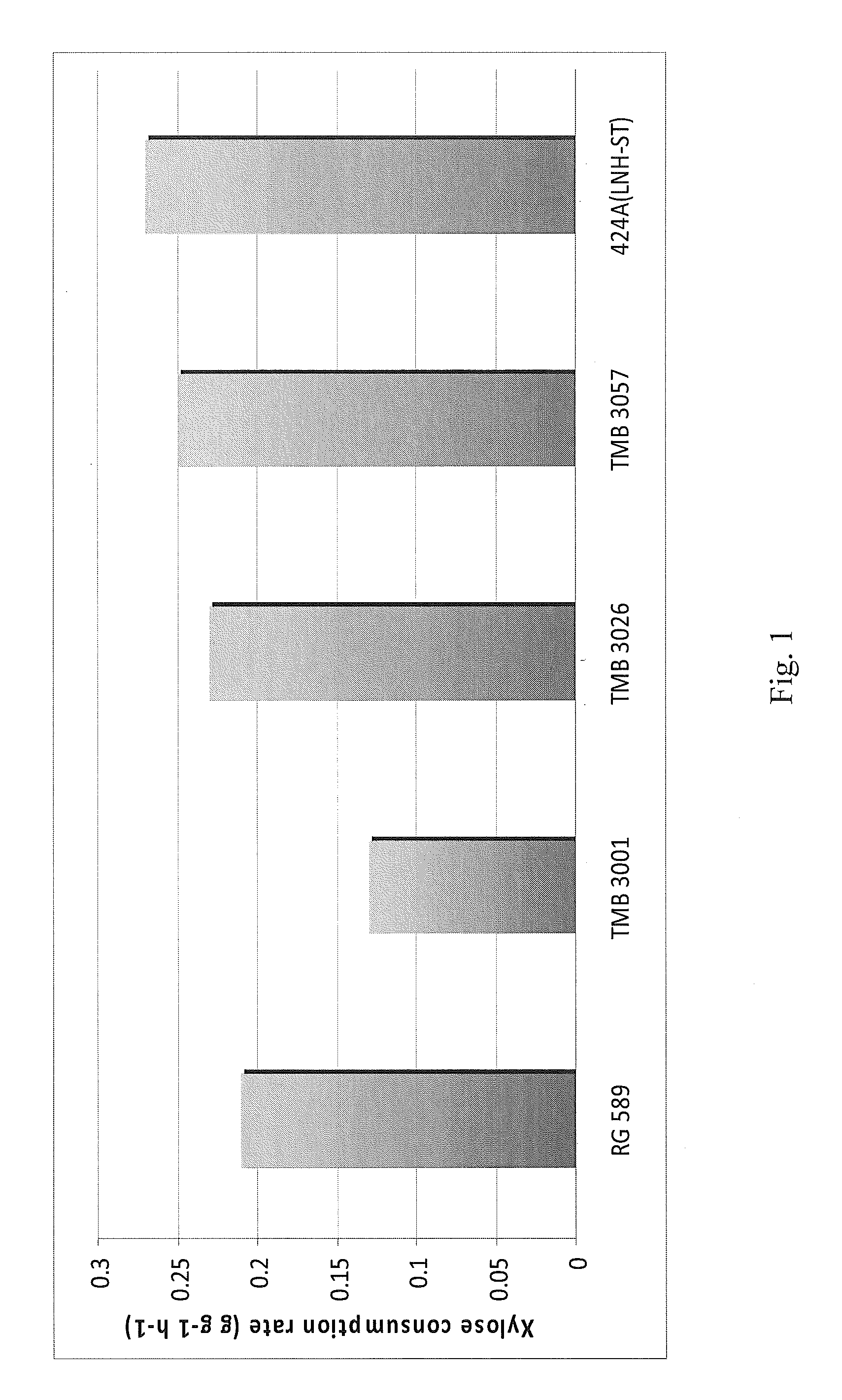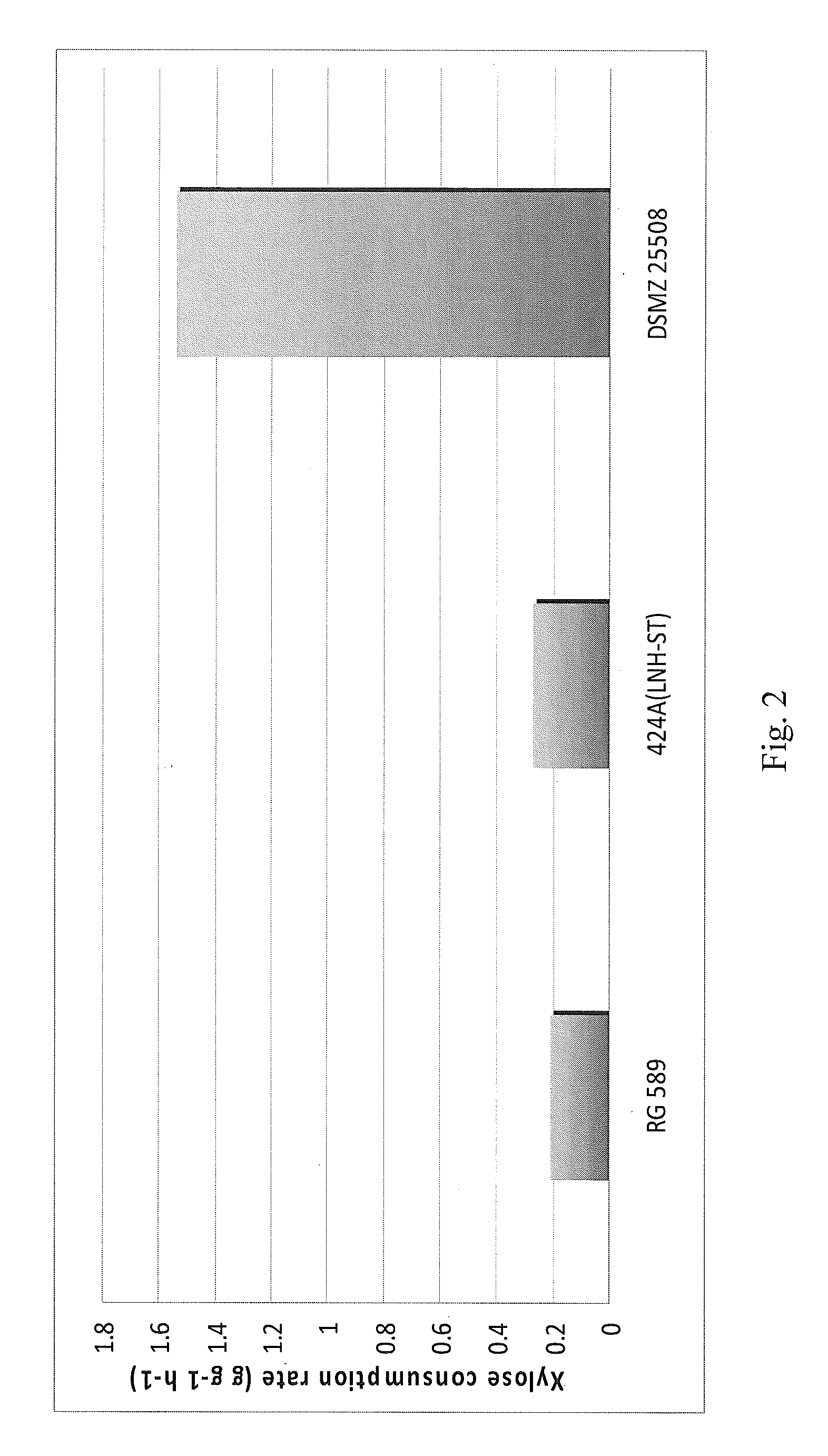Isolated yeast strain having high xylose consumption rate and process for production of ethanol using the strain
a technology of xylose and fermentation process, which is applied in the direction of biofuels, enzymology, transferases, etc., can solve the problems of high cost and pollution, insufficient ethanol production from these sources, and high cos
- Summary
- Abstract
- Description
- Claims
- Application Information
AI Technical Summary
Benefits of technology
Problems solved by technology
Method used
Image
Examples
example
Example 1
Cloning of Xylose Metabolism Genes and Construction of Recombinant Plasmid
[0036]Thirty wild type strains obtained from the Food Industry Research and Development Institute (FIRDI) were cultured and selected using SX medium containing 10% ethanol and one strain having high tolerance to high level ethanol, S. cerevisiae BCRC 22743, was selected. The following genes were cloned using polymerase chain reaction (PCR) under the following conditions:
[0037]1.pGK Promoter
[0038]Length: 643 bp
[0039]Type: DNA
[0040]Original strain: Saccharomyces cerevisiae
[0041]Gene annotation: pGK promoter
[0042]
Primer forward:(SEQ ID NO: 1)GACTACGCATGCGGCGCGAATCCTTTATTTTGGCTTCPrimer reverse:(SEQ ID NO: 2)TGAATTACTGAACACAACATTGTTTTATATTTGTTGTAAAAAGTAG
[0044]Length: 957 bp
[0045]Type: DNA
[0046]Original strain: pichia stipitis
[0047]Gene annotation: Xylose reductase
[0048]
Primer forward:(SEQ ID NO: 3)AAAACAATGCCTTCTATTAAGTTGAACTCTPrimer reverse:(SEQ ID NO: 4)CAATTCAATTCAATTTAGACGAAG...
example 2
Xylose Metabolism and Ethanol Production of the Selected Transformant
[0068]Five transformed strains capable of using xylose and producing ethanol were selected from over 1,000 S. cerevisiae transformants according to the procedures stated in Example 1 and were named as S. cerevisiae RG 352, S. cerevisiae RG 758, S. cerevisiae RG 316, S. cerevisiae RG 527 and S. cerevisiae RG 589. Among the selected strains, S. cerevisiae RG 589 is able to produce highest ethanol concentration (16 g / L) in 5% SX medium and achieve 0.21 g xylose / g biomass / hour of xylose consumption rate. However, the above-mentioned results are better than those of strain TMB 3001 but do not have significantly differences from those of the strains TMB 3026, TMB 3057 and 422A (LNH-ST). The comparative xylose consumption rates are shown in FIG. 1.
example 3
Preparation of Mutants of S. cerevisiae RG 589
[0069]S. cerevisiae RG 589 cells were treated with ethyl methanesulfonate (EMS) solution for 20 minutes to obtain mutants. The resulting solution was centrifuged and the supernatant was removed. The residual cell pellet was washed with 0.1 M phosphate buffer (pH 6) twice. After appropriate dilution, the cells were inoculated in 5% SX medium (Yeast Nitrogen Base 4.7 g / L and, Xylose 50 g / L) and cultured at 30° C. with 200 rpm shaking. If a mutant cultured at a concentration of 50 g / L xylose can utilize xylose for maintainence, growth, metabolism and production of ethanol, it has better ability in using xylose. After culturing the mutants at the concentration of 50 g / L xylose for three days, the mutants were taken out and then performed the above-mentioned mutation and culture process twenty times. The resulting mutants were plated at SX medium plate for mutant selection. After two days, the mutant growing fast was selected and named as S. ...
PUM
| Property | Measurement | Unit |
|---|---|---|
| diameter | aaaaa | aaaaa |
| temperature | aaaaa | aaaaa |
| temperature | aaaaa | aaaaa |
Abstract
Description
Claims
Application Information
 Login to View More
Login to View More - R&D
- Intellectual Property
- Life Sciences
- Materials
- Tech Scout
- Unparalleled Data Quality
- Higher Quality Content
- 60% Fewer Hallucinations
Browse by: Latest US Patents, China's latest patents, Technical Efficacy Thesaurus, Application Domain, Technology Topic, Popular Technical Reports.
© 2025 PatSnap. All rights reserved.Legal|Privacy policy|Modern Slavery Act Transparency Statement|Sitemap|About US| Contact US: help@patsnap.com


